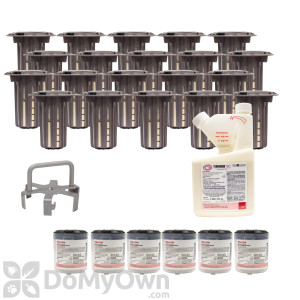How To Use A Termite Baiting System
By DoMyOwn staff
There is no preventative or control method that can guarantee that you will never get termites. However, you can greatly reduce the chances of termite invasion and manage current infestations by installing an appropriate Termite Baiting System, in combination with traditional termite control methods such as soil treatments, moisture control, foaming, removal of competing food sources, etc.
Top Reccommended Termite Baiting Systems:
Advance Termite Bait System - Pro Kit -This kit contains 15 Termite Monitoring Stations, 15 Wood Bases, 15 termite inspection cartridges, 6 Termite Bait Cartridges for use when termite activity is present in the stations and 1 Spider Access Tool for easy access to the bait stations.
FirstLine Termite Defense System Kit (Includes GT Bait) - Complete Starter Kit for the Firstline Termite Defense System. Everything included to provide your own Termite Control. This kit includes 24 monitoring stations with wood inserts and summon discs for each station and 6 GT Plus toxicant baits.
Termite Bait System Basics
Termite Bait System Basics
Termite baiting is a fairly recent method of termite management designed to replace the traditional and less-effective method of a liquid chemical barrier treatment. The 3 basic steps of the termite baiting process include:
- Pre-baiting - Monitoring stations are placed in the soil to establish a feeding cycle between the termite colony and the bait station. These pre-baited stations include a piece of wood or inspection cartridge rather than the actual termite toxin.
- Introduction of Toxic Bait - As soon as the termites begin feeding on the wood or inspection cartridge, the pre-bait is replaced with the active bait. (Putting out the toxic bait too soon would result in killing off the very workers needed to establish the feeding cycle).
- Population Reduction - Termites begin feeding on the active bait and transfer it to the entire colony. In theory, the entire colony is eliminated. However, with any termite control plan, population reduction is a more practical goal than termite elimination, since there is really no substantial evidence to show that complete colony elimination is possible.
What are Termite Baits?
Termite baits are made from substances that termites already love to east-such as paper and cardboard- combined with a slow-acting poison that is lethal to termites.
Delayed-Action is Better
If you have a termite problem; you probably want to kill off those little critters as quickly as possible! However termite baits must be slow-acting because if the bait kills too quickly, the bait stations and vicinity would begin to fill with sick or dying termites, which would then cause other termites who might take the bait to avoid it altogether. Delayed-action baits also allow for transmission of the toxic bait to other termites that do not ingest the bait firsthand.
Monitoring is KEY
Unlike ants and roaches, termites are not "attracted" to food baits. Instead, termites forage randomly around their colonies in search of food until they have covered every inch surrounding the colony and located all available food sources. Whether you hire a professional to come out monthly and monitor your stations, or you decide to do it yourself, consistent monitoring is absolutely critical during all stages of the baiting process.
Here's how to do it:
- Monitoring the Pre-bait Once you have placed inactive bait stations containing a piece of wood or inspection cartridge in the ground, it may take time before the termites actually find the bait, since they are not immediately "attracted". Research has shown that it can take a termite colony between 1 to 5 months to find a bait station in the southern states, and up to a year or more in northern states. Patience and consistent monthly monitoring is the key. The pre-bait should be replaced with an active bait as soon as it shows signs of feeding.
- Monitoring the Active Bait Continue to monitor the bait station every month while the active bait is in place. You are looking for feeding activity. As long as feeding activity is evident, the active bait may be left in place. Once feeding activity has stopped however, it should be assumed that the colony has been eliminated, and the active bait may again be replaced with a monitoring device such as a piece of wood or inspection cartridge.
- Repeat The process is then repeated with monitoring the pre-bait on a monthly basis and replacing with active bait as needed to prevent and manage future infestations.
View all Termite Control Products
5 of 5 people found this article informative and helpful.
/1331_with_trelona_(003).jpg.thumb_300x300.jpg)
/145_with_trelona_(004).jpg.thumb_300x300.jpg)
